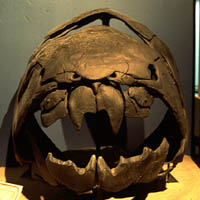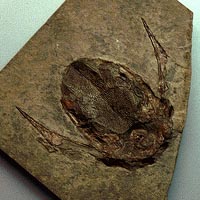Introduction to the Placodermi
Extinct armored fishes with jaws


Click on either picture to view an enlargement!


Click on either picture to view an enlargement!
Unlike all other jawed vertebrates, placoderms never had teeth, and did not descend from toothed ancestors. Instead, bony plates associated with the jaws performed the function of teeth, sometimes forming razor-like, literally self-sharpening edges (as can be seen in Dunkleosteus on the left). Additional peculiarities of the skull, such as nasal capsules that were not fused to the rest of the braincase, distinguish placoderms from all other jawed vertebrates. Furthermore, in 1997, a placoderm fossil from Antarctica was found to contain preserved pigment cells: iridescent silver on the ventral side (belly) and red on the dorsal side (back). Placoderms are the oldest vertebrates for which we know something about their color in life. This further implies that placoderms may have had color vision.
The evolutionary history of placoderms has been compared to a brilliant light bulb that soon burns out. They were a highly successful and diverse taxon, but they lasted only about fifty million years. Contrast this with the history of sharks, which appeared at about the same time as placoderms -- but which have survived for over 400 million years! In a sense, placoderms represent an "early experiment" in the evolution of jawed fish; they radiated into a number of body shapes and ecological niches, which were occupied by other fish lineages after the extinction of the placoderms. The oldest placoderms known, found in China, appeared in the later part of the Early Silurian. However, placoderms reached their greatest diversity in the Devonian, the so-called "Age of Fishes". A number of Devonian placoderms have been found in freshwater habitats: placoderms included some of the first vertebrates to colonize fresh water. They also included the earliest vertebrates to colonize the open ocean. The Devonian saw the greatest diversity of a large number of fish taxa, including not only placoderms, but armored jawless fishes, early Chondrichthyes, and the first ray-finned and lobe-finned fishes. Many of these taxa died out around the end of the Devonian Period for reasons that are still not well understood. Placoderms survived until the very end of the Devonian, and their extinction appears to have been quite sudden, but its causes are still unknown.
The images on this page show representatives of the two largest and best-known taxa of placoderms. On the left is Dunkleosteus, a marine predator from the Devonian of Ohio that is a member of the most diverse subgroup of the placoderms, the Arthrodira. Dunkleosteus reached estimated sizes of up to twenty feet (six meters) in length -- which makes Dunkleosteus and related species among the largest animals, of any kind, in the Devonian. Its skull is about four feet (1.3 meters) at its widest point, and its armor plates are as much as two inches (five centimeters) thick. Scars and wounds sometimes preserved on the bony armor of this and other placoderms match the jaws of fish like Dunkleosteus, demonstrating that Dunkleosteus was not only a predator, but was not above attacking its own kind! Most arthrodires, however, were smaller than Dunkleosteus and may have fed on molluscs, crustaceans, and other invertebrates.
A much smaller placoderm, Bothriolepis from Escuminac Bay, Québec, is shown on the right, representing the placoderm subgroup Antiarcha. The armored head of Bothriolepis was only about four inches (ten cenitmeters) across. The unusual "paddles" on either side of the boxy armored body are the pectoral fins, which were armored in Bothriolepis and related species; the hole in the top of the head housed both the nostrils and the eye sockets, set close together. Bothriolepis and other antiarchs inhabited both freshwater and marine environments, including lagoons, rivers, deltas, and coastal environments, and probably fed on invertebrates such as crustaceans and molluscs. Other placoderm taxa included flattened, stingray-like forms (rhenanids), forms with long spines (petalichthyids), and slender, streamlined forms with crushing tooth plates (ptyctodontids).


